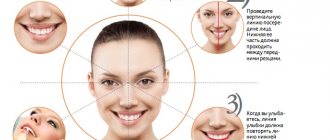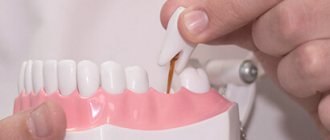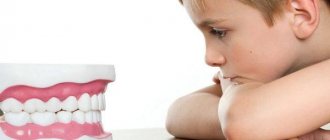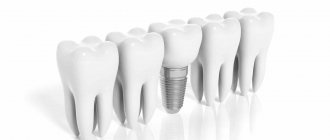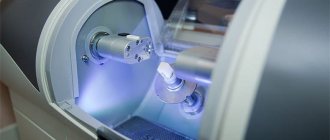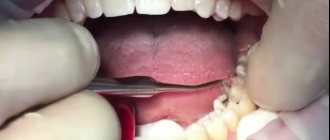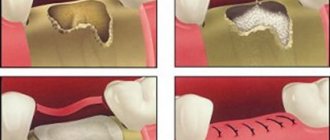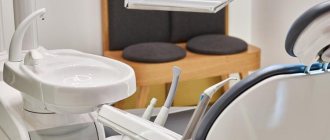The technology of installing artificial roots and then attaching dental crowns to them is becoming more and more popular every year. This is explained by several reasons. Firstly, every year there are more and more clinics in which dentists have mastered this technology. The second reason is the successful development of the technology itself, which has led to fewer and fewer cases of implant failure. Finally, the materials themselves are becoming higher quality, and therefore more durable.
PIC-Optima as a replacement for titanium implants
PIK-Optima is a new biological polymer material from which it is possible to produce implants that are not inferior in their characteristics to titanium analogues. This material was created by French scientists. In 2005, a pilot batch of artificial dental roots was produced from it for the first time. Implants made from PIC-Optima biopolymer have the following advantages:
- very long service life;
- maximum similarity of the material to the bone structure of the jaw;
- the material does not cause an allergic reaction in patients;
- high resistance to chemical influences.
It is also noteworthy that PIK-Optima can be used both to strengthen soft tissues and to strengthen and even replace bone tissue in the oral cavity. Moreover, unlike titanium alloys, this material is very plastic. This allows implants to be manufactured to a given size as accurately as possible, and the flexibility of the material does not provoke bone tissue destruction.
Motivational component
Of course, it’s no secret that rarely does anyone go to the dentist’s chair voluntarily. For preventive purposes, even more so. However, now there are techniques thanks to which patients themselves will be ready to visit a specialist as often as possible. And they concern the motivational component. For example, today we often use digital design to help model the patient’s future smile. This manipulation should be carried out in the first stages of treatment, when the planning of procedures is still underway.
Previously, doctors showed patients examples of their successful work so that they could make sure that they were looking at a professional. In addition, this option also had an educational nuance: using visual examples, it was possible to explain what would have to be done during therapy. Now everything has become more targeted, detailed and individualized. Of course, it is more interesting for a person to see what will be in his mouth than to hope for a repetition of someone else’s result. A motivational program is especially in demand in situations when it comes to correcting a bite or installing veneers, i.e. working with the front teeth. This is in fact a kind of fitting from a photo.
Article on the topic
Will beer cause tooth decay? 9 Everyday Habits That Damage Your Teeth
Zirconium dioxide implants
Implants made from zirconium dioxide successfully replace metal structures. In addition, zirconium implants are implanted into bone tissue much faster than titanium ones. Zirconium dioxide is highly resistant to mechanical loads, both static and dynamic. It is quite easy to process and integrate into the jaw bones.
The advantages of the material include:
- high strength;
- long service life;
- no allergic reaction in patients.
Zirconium dioxide, unlike titanium alloys, does not release metal microparticles into the soft tissues of the oral cavity.
Modern clasp dentures
This is a structure that is represented by an arc on which the required number of implants is fixed. In this way, it is possible to replace a large number of teeth in one jaw, provided that the original healthy teeth still exist.
Clasp prosthetics are a heavy-duty design with a long service life. Disadvantages of the technology - the metal structure has many hooks and clasps, which does not allow the jaw to look aesthetically pleasing. Also, this type of prosthetics is characterized by a long adaptation period, but indisputable positive aspects should also be highlighted:
- Cheapness
- Easy to maintain structure.
- No negative effect on gum tissue.
Crowns for such prostheses can be made at the request of the patient. At this stage, the main materials are: ceramics, metal ceramics and porcelain.
Basal implantation
Basal dental implantation is considered a relatively new technology; it is not mastered in all Russian dental clinics. This method is used both for complete loss of teeth and for the absence of one or more teeth. Basal implantation allows you to install a dental crown on an artificial root without waiting for it to grow tightly into the bone tissue. This method has become truly revolutionary, since the implantation of conventional titanium implants can last more than one month, and all this time the patient experiences discomfort in the oral cavity.
Initially, basal implantation involved the use of lateral implants with a disc base. Unfortunately, they did not perform as expected. Bone tissue often rejected such an implant. In addition, soft tissue injury sometimes occurred during the installation process. Nowadays, such implants are not used at all in dentistry. Instead, dental surgeons use screw implants with deep threads and a large thread pitch at the bottom of the implant. This ensures the initial tight fit of the structure in place. Artificial dental crowns are very conveniently attached to screw implants. Basal implantation is indicated:
- with partial or complete loss of teeth;
- with partial atrophy of the jaw bone;
- if the patient does not want to increase jaw bone tissue;
- If necessary, urgently install an artificial tooth.
Basal implantation is not used in the following cases:
- the patient suffers from diabetes;
- the patient is HIV-infected;
- the patient is sick with tuberculosis;
- the patient has extremely low immunity;
- the patient suffers from nervous or heart diseases;
- the patient has cancer
- The patient has a tone of the masticatory muscles.
Basal implantation is characterized by extremely rare injury to the soft tissues of the oral cavity. At the same time, implantation of the implant into the jaw bone proceeds very quickly. Suffice it to say that within 3-7 days after implantation the chewing function returns to normal. Practice shows that only in ten cases out of a hundred patients require bone tissue augmentation before basal implantation. The cost of basal implantation is half that of classical implantation in two stages.
In our country, dentists prefer to use Swiss Oneway Biomed implants for basal implantation. They are produced by reputable companies Ihde Dental AG and ROOTT. Much less commonly used in Russia are German shortened Triton Titanium implants, as well as Israeli extended zygomatic implants Noris Medical.
Smart toothbrush
You won’t surprise us with “smart” electronic devices, and now these electronics have reached the bathroom. The Kolibree “smart” electronic toothbrush, together with the corresponding application, allows you to remain confident that you are brushing your teeth correctly, and also offers children fun games that teach them to brush their teeth correctly and regularly.
Philips also released its own brush that works via Bluetooth, including it in its already fairly large line of smart consumer medical devices. It uses a set of sensors to track how you brush your teeth in real time. And it does it extremely simply and clearly. The app shows a 3D map of the user's teeth, showing the teeth they are currently brushing and telling them if they have been brushing too little or too long. It also warns of too much pressure or a harsh cleaning style.
ROOTT implant system
The Rutt system includes more than a hundred different implants. This allows materials from a single manufacturer to carry out any type of artificial root implantation. Rutt System implants can be fixed into the jawbone using dental cement, multi-unit or ball-shaped attachments.
The basal implants of the ROOTT system are structurally a single piece with an adapted abutment. The surface of these implants is perfectly smooth, which virtually eliminates the deposition of bacteria. Moreover, such implants are implanted very quickly due to deep threads. Finally, such artificial roots can be installed immediately after the removal of a damaged tooth. Advantages of Rutt system implants:
- minimum cases of rejection;
- ease of installation;
- no contraindications for patients with HIV, AIDS, hepatitis and diabetes;
- installation is allowed for heavy smokers
- the ability to implant roots in case of periodontal diseases.
Artificial intelligence
Already, dentists are using software to provide information to make clinical decisions. Soon such programs will work on the basis of AI algorithms, which will significantly facilitate the work of a doctor.
Such intelligent algorithms can be integrated into the healthcare system to analyze health data, research results and treatments to offer diagnostic and therapeutic recommendations for individual patients.
This will be possible thanks to the accumulation of information, in particular genetic data, which will allow a deeper understanding of the system of individual care for each patient. With AI tools that have access to such information, doctors will be able to select the best treatment options and increase the likelihood of success.
With ever-growing health data, AI algorithms can help professionals better manage dental problems. In 2022, researchers developed a machine learning method to accurately quantify immune cells near oral cancer cells. This gives a better idea of the cancer's spread and resistance, thereby helping to determine the chances of survival. Others are using neural networks to better detect tooth decay and periodontitis in X-rays. Such approaches may become standard practice in the near future.
Implants with tapered abutment connection
Such structures are non-demountable. Their conical abutment ensures uniform load over the entire area of the implant, which dramatically reduces the likelihood of root loosening while chewing solid food. Such implants can be installed below the level of the cortical bone, in the area of which there is very little blood circulation.
The advantages of this technology are:
- monolithic design;
- uniform load distribution over the entire area of the implant;
- impossibility of penetration of pathogenic microorganisms to bone tissues:
- fast and very tight implantation of the implant into bone tissue;
- the technology does not interfere with normal blood circulation in the oral cavity;
- natural appearance;
- long service life.
Comments
[…] be sure to read about the latest trends in the development of implantation in recent […]
How to treat gingivitis. Causes of the disease and methods of treatment. (06/20/2018 at 09:01) Reply to comment
[…] by 3 x”, then we recommend that others pay attention to the trends in implantation that have taken hold in 2022. Fill in defects [...]
All-on-3 prosthetics, description and features of the method (07/18/2018 at 09:00) Reply to comment
[…] on a computer, involves a careful 3D modeling process. Working through allows you to avoid mistakes and get [...]
How to insert teeth in less than a week using innovative methods. (09/01/2018 at 09:01) Reply to comment
Write your comment Cancel reply
Latest achievements in Israeli dentistry
Nowadays, Israeli dentists implant artificial roots using their own technology. Its main difference is the long duration of the operation. It usually lasts from 4 to 8 hours.
Painkillers are introduced gradually and using Sleeper One technology. This ensures maximum comfort for the patient. The first effect of anesthesia begins only 40 minutes after the start of the injection. At the same time, by the beginning of the operation itself, the nerve endings in the jawbone area are completely blocked.
Implantation of artificial roots in Israel is done only in inpatient departments of dental clinics. The time for postoperative rehabilitation there lasts at least three days. During this time, the patient should be absolutely at rest and strictly follow the doctor’s recommendations. Postoperative drug treatment is carried out strictly individually and taking into account the characteristics of the patient’s body. In most cases, dentists prescribe anti-inflammatory and antibacterial agents.
Treatment of caries
Poor nutrition, the use of certain medications or heredity can cause the development of caries. Fortunately, this common condition can be treated with the latest techniques used by dentists.
Chemical-mechanical treatment
With this method, infected dentin is removed not only painlessly, but also silently. Healthy tissues are not damaged at all.
A special gel is applied to the affected area, which softens carious deposits. After its removal, a small cavity remains, which requires less filling material. Chemical-mechanical treatment does not require anesthesia, since only necrotic areas of dentin that do not have innervation are removed.
Laser technology
With this technique, drilling is not performed, since the affected tissue is burned out by the laser beam.
In parallel with this, disinfection of the cavity occurs, since the laser kills any bacteria.
What implants do Japanese dentists use?
Japanese scientists under the leadership of Professor Takashi Tsuji managed to develop a biohybrid dental implant. Its structure is not much different from the structure of human bone. Such implants almost never fail. In simple terms, the essence of the invention of Japanese scientists is that the titanium base of the implant is covered on all sides with a layer of a unique material consisting of hydroxyapatite and stem cells of dental follicles. This layer is precisely an analogue of human bone tissue.
Such implants are quickly and most importantly firmly implanted into the jawbone and, what is most surprising, after a while the artificial tooth begins to function like a real one. It is able to sense pain, mechanical impact and the temperature of food or drink.
It should be said that work on creating such a coating continues. Biohybrid implants have not yet been installed en masse, but this will certainly happen. As for a considerable number of experiments on volunteers, they showed excellent results. Biohybrid implants are indicated:
- with partial and complete loss of teeth;
- with severe thinning of the jaw bone;
- if the patient refuses bone tissue augmentation;
- if urgent restoration of the dentition is necessary after the loss of one or more teeth.
Trend No. 5: virtual modeling and 3D printing in dentistry
This is perhaps one of the most interesting trends in recent years, since it is directly related to the active development of computer technology throughout the world. No, no, we are not talking about robots installing implants. The point is that 3D modeling capabilities come to the aid of implantologists.
The process of creating a 3D model of a patient's jaw
The implantologist literally predicts the entire treatment process in advance on the computer - computed tomography data is loaded into the program, then the entire jaw system of the patient is literally drawn, and the implants are virtually installed. But what happens next is even more interesting! Some clinics print templates on a 3D printer - they are used when implanting implants. To ensure that this process goes smoothly.
Today, for this purpose, programs are again used by Nobel (Procera, Cerec), Straumann, Dentsply - that is, world leaders in the field of dentistry in general and implantology in particular.
New developments by Malaysian scientists
In Malaysia, scientists have also developed their own special implant, which is intended for older people. The essence of their invention is fundamentally reminiscent of the development of their Japanese colleagues. Malaysians also coat the titanium rod and implant abutment, but with a completely different layer. This protective layer consists of ceramics and magnesium silicate. This layer is also very quickly implanted into the bone tissue.
In addition, Malaysian scientists have come up with a new method for making titanium implants. Its essence consists in microwave sintering of the implant after it is coated with titanium powder.
A leading specialist in the development of new dental technologies in Malaysia is scientist Alirez Yaghoubi. He heads an entire scientific group of highly qualified specialists. This group is developing personalized dental systems. In their opinion, this approach is the most promising.
CRISPR
CRISPR is the latest method of genome editing, which nature itself provides us with and which scientists have only now learned to use. Already today, research is being conducted into the possibility of using this method to combat cancer and other serious diseases; it can also be used in dentistry.
Researchers believe that dental specialists will soon be able to identify genes associated with many oral pathologies. And when this becomes known, it will be possible to find a CRISPR solution that will allow you to properly edit the structure of the defective gene and get rid of dental problems in early childhood.
* Dentin is the hard tissue of the tooth, making up its main part.
Materials used: The Verge, Medical Futurists, VRScout, The Guardian, WebMD, Dental Products Report, Nature
Expected prospects in the field of dental implantation
Modern implants from well-known manufacturers no longer need replacement. The appearance of artificial teeth is practically no different from the appearance of real healthy teeth. However, scientists continue to work to further improve this technology. The ultimate goal in this area of dentistry is to be able to completely imitate the patient's natural dentition.
Spanish scientists have already managed to take the first step in this direction. They created an artificial tooth root, the protective layer of which, during the process of implantation, decomposes and turns into natural bone tissue.
Augmented Reality
The University of Strasbourg in France is using augmented reality for coursework and practical work to demonstrate dental models to students and allow students to compare the prosthetics they create with reference models. Faculty at this university believe that in just a few years, augmented reality technology will completely revolutionize dental education.
A similar device, called the DentSim Simulator, was developed by Image Navigation - it uses augmented reality technology for simulation, allowing students from all over the world to hone their skills. This training system has already been used by 10 thousand dentists from 17 countries.
A little bit of a wizard
Vladimir Lutsenko, the founder and head of the Russian company producing bite-correcting mouth guards - or aligners - Star Smile, aims to make high-quality orthodontic treatment accessible to most patients, including children.
This is possible thanks to the introduction and development of modern technologies and special Star Smile programs:
- through participation in all leading Russian and international dental conferences,
- through speeches to students at leading dental universities in the country,
- through the publication of both popular materials and medical articles.
- and also through the training of orthodontists and dentists (!!) in Russia and neighboring countries through our Star Smile School.
Today, Star Smile technologies in the field of orthodontics cover more than 100 cities
Russia, and, importantly,
more than 25 countries
of the world, including the USA, Japan, Israel, Australia, and most European countries.
“Beauty and health improve the quality of life of any person, and a beautiful smile especially. And I’m glad that I can contribute to the development of these opportunities for everyone,” says Vladimir Lutsenko.
Teledentistry
Patients with special needs, elderly people in nursing homes and people living in rural areas have difficulty accessing a dentist and almost never have a choice. This may change significantly with the rise of teledentistry.
Telemedicine services, already offered in the US by companies such as Teledenists and MouthWatch, make it easier to access dental services. These services are significantly less expensive for patients, offer lower-cost prevention options, and allow patients to consult with otherwise unavailable health care providers. For example, MouthWatch's TeleDent service offers an all-in-one teledentistry platform that allows patients to take photos of their mouth or teeth, remotely send relevant information to the dentist, and conduct consultations in real time. The dentist can start a video chat with the patient and caregiver so that the provider can actually see and talk to the patient, establish rapport with them, and then bring them into the doctor's office (if necessary).
Candid, which provides teeth straighteners and treatment plans to patients, has tested a technology called Dental Monitoring that involves handing patients a connected ScanBox device. The device looks like a virtual reality headset. But instead of covering people's eyes, it looks into their mouths and controls how they use the aligners.
The ScanBox connects to the patient's smartphone, captures images and sends them to a remote orthodontist. The uploaded images are also scanned by an artificial intelligence algorithm which can track the patient's progress, assess oral hygiene and identify any potential health problems such as visible tooth decay or gum recession.
An orthodontist reviews each patient's case, determines whether they are eligible for treatment, and if so, creates a treatment plan. The aligners are then mailed to patients, who typically must be at least 16 years old and have mild to moderate alignment problems.
We also note that as the importance of remote care has increased during the pandemic, telemedicine is also gaining momentum, and authorities are responding accordingly.
How form affects content
Appearance and facial expression largely depend on the shape and position of the teeth. This can be seen most clearly by looking at domestic or foreign stars who have certain characteristics of their bite. For example, Anne Hathaway's
wide
and the even, slightly protruding upper row of teeth make her face open and kind. Amal Clooney, who looks similar to her,
:
The upper teeth are more crowded and turn slightly inward, which gives the impression of a purposeful and more solid person.
The characteristic gap between the front teeth (in medical terms - diastema) always remains in fashion and emphasizes individuality; many world celebrities prefer to leave it as is, for example, the famous Frenchwoman Vanessa Paradis:
Ordinary people prefer to close the diastema, since this “defect” also affects diction and facial symmetry.
Alternative to pills and surgery
Headaches, migraines, neck stiffness, and sharp back pain often have an unknown cause. People have been treated by neurologists and neuropathologists for years, mainly because pain is temporarily relieved with the help of injections and other manipulations. The appearance of these people is also transformed, the face becomes tense, and a frozen mask is formed.
“Almost a quarter of these patients do not even know that they need the help of an orthodontist,” says Vladimir Lutsenko. “Star Smile technology can improve their health and change their quality of life!” The connection between malocclusion and postural disorders is very strong and one must be able to break it; aligners successfully cope with this task.
A striking example is when a patient does not pay attention to caries and tooth decay until it hurts. And in such cases, it happens that patients endure until the last. Or they don’t understand why the teeth suddenly became crooked (and it was the wisdom teeth that began to erupt). So they suffer.
